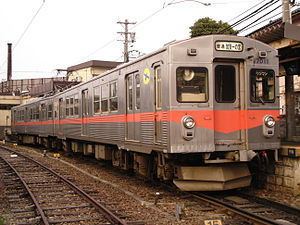The Hokuriku Railroad Ishikawa Line (北陸鉄道石川線, Hokuriku Tetsudō Ishikawa-sen) is a railway line owned and operated by Hokuriku Railroad in Ishikawa Prefecture, Japan. The line extends 13.8 km from the city of Kanazawa to Hakusan with a total of 16 stations.
All services are all-stations "Local" trains which travel the entire length of the line, from Nomachi to Tsurugi; the trip takes approximately 30 minutes. During the New Year's Eve and New Year's Day holidays, the line was operated all night to move passengers to and from now-closed Kaga-Ichinomiya, where the nearby Shirayama-Hime Shrine draws crowds.
All trains are operated by drivers only; doors in the middle of each train car do not open.
Until November 30, 2006, there was daytime semi-express service between Nomachi and Tsurugi; trains stopped at Osano, Nonoichi, Sodani, and Oyanagi, making the trip in 25 minutes. This semi-express service was intended to move trains from one part of the line to the other in order to have a more balanced schedule.
On November 1, 2009, the section between Tsurugi and Kaga-Ichinomiya was closed.
Hokuriku Railroad uses ten 7000 series (formerly Tokyu 7000 series) and eleven 7700 series (formerly Keio 3000 series) electric multiple units (EMUs) on the Ishikawa Line. They are typically run in paired sets.
June 22, 1915: Ishikawa Electric Railway begins operating the 762mm gauge line between Shin-Nonoichi and Tsurugi stations, not electrified despite the company's name.June 30, 1915: Ishikawa Electric Railway renamed to Ishikawa RailwayDecember 1, 1916: Kami-Nonoichi Station opensAugust 1, 1921: Track gauge changed to 1,067 mm; electrified with 600 V DC overhead catenaryOctober 1, 1922: Nishi-Kanazawa — Shin-Nonoichi section opened by Kanazawa Electric Railway, through operation with Ishikawa Railway startsMay 1, 1923: Kanazawa Electric Railway absorbs Ishikawa RailwaySeptember 5, 1925: Hinomiko Station opensOctober 1, 1925: Nishi-Kanazawa Station renamed to Shiragikuchō Station; Shin-Nonoichi Station renamed to Shin-Nishi-Kanazawa Station; Kami-Nonoichi Station renamed to Nonoichi StationAugust 17, 1927: Sanjūgari Station opensDecember 28, 1927: Kinmei Railway opens Tsurugi — Jinjamae (now Kaga-Ichinomiya) sectionMarch 11, 1929: Tsurugi — Jinjamae section transferred to Kanazawa Electric RailwaySeptember 14, 1929: Tsurugi — Jinjamae section electrifiedDecember 1, 1934: Nishi-Izumi Station opensMarch 2, 1935: Awada Station opensAugust 1, 1937: Inokuchi Station opensDecember 8, 1937: Jinjamae Station renamed to Kaga-Ichinomiya StationAugust 1, 1941: Hokuriku Gōdō Electric (now Hokuriku Electric Power Company) established; merges with Kanazawa Electric RailwayMarch 26, 1942: Hokuriku Gōdō Electric spins-off its transport division, establishes Hokuriku RailwayFebruary 1, 1943: Magae Station opensOctober 13, 1943: Hokuriku Railway, Kanaishi Electric Railway, Onsen Rail, Kinmei Railway, Noto Railway, etc. merge to form Hokuriku RailwayOctober 23, 1944: Through operation with the Shōkin Line beginsAfter 1946: Sanjūgari, Tsukihachi stations closeJune 2, 1949: Through operation with the Nōmi Line beginsAfter April 1963: Awada Station renamed to Otomaru StationApril 11, 1963: Kami-Nonoichi Station renamed to Kōsen-Mae StationJuly 15, 1965: Ōnuke Station renamed to Nuke-Jūtaku-Mae StationSeptember 15, 1966: Kōsen-Mae Station renamed to Nonoichi-Kōdai-Mae StationApril 1, 1970: Passenger operations on the Shiragikuchō — Nomachi section cease; freight-only operation continuesSeptember 20, 1972: Shiragikuchō — Nomachi section closesApril 1, 1976: Freight operations ceaseSeptember 14, 1980: Nōmi Line closesDecember 12, 1984: Kinmei Line operation stopsApril 29, 1987: Kinmei Line closesJuly 24, 1990: Driver-only operation begins2002: Automatic Train Stop (ATS) system introducedDecember 1, 2006: Semi-express trains abolished; entire line changes to local-only operationNovember 1, 2009: Tsurugi — Kaga-Ichinomiya section closesMarch 14, 2015: Hibari station opensNomachi Station: In 1904, the 8 km, 915 mm gauge Matsukane horse-drawn tramway opened to Matto on the Hokuriku Main Line, and also connected with Nonoichi station on this line (not the current JR West station of the same name, which opened in 1968). In 1916, the line was converted to 1,067 mm gauge and electrified at 600 V DC. The line was acquired by the Kanazawa Electric Railway in 1920, which merged with the Hokuriku Railway in 1942. The 3 km Nonoichi to Nomachi section closed in 1944, and the remaining 5 km line closed in 1955.Tsurugi Station: The 17 km line to Yamashita was opened between 1926 and 1929, and electrified in 1949. Freight services ceased in 1971, and the line closed in 1983 after the Dainichigawa bridge was damaged by floodwaters. The Nomi Electric Railway opened a 17 km line, electrified at 600 V DC to Terai on the Hokuriku Main Line in 1927. Flooding destroyed the Tedorigawa bridge in 1934, which was replaced nine months later. The company merged with the Hokuriku Railway in 1942. Freight services ceased in 1968, and the line closed in 1980.
